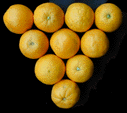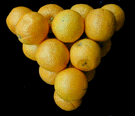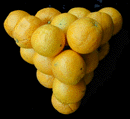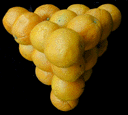 |
|
Packing Pennies in the PlaneAn illustrated proof of Kepler's conjecture in 2Dby Bill Casselman |
NOTE: This month's contribution contains several Java applets.
They may not work on your particular computer, for any
of various reasons. If you do not have Java enabled
in your browser, for example, you will
see only static images representing
the animated applets. If you have trouble
with viewing the applets even though
Java is enabled, or if you want to print out
this note, you should disable Java.
If Java is enabled and you still have trouble viewing the applets,
please let Bill Casselman
know about it.
He didn't elaborate much, and his statement lacks precision.
It is almost certain that he had no idea that this assertion
required rigorous proof. At any rate, this claim came to be known as
Kepler's conjecture, and it turned out to be extremely
difficult to verify.
This note will follow Hales'
suggested argument for the 2D conjecture, filling in a few minor
gaps here and there, and relying almost
exlusively on illustrations and a few animations
to explain the reasoning.
Bill Casselman1. "Kepler's Conjecture"

In his book De nive sexangula
(`On the six-sided snowflake') of 1611, Kepler asserted that the
packing in three dimensions made familiar to
us by fruit stands
(called the face-centred cubic packing by crystallographers)
was the tightest possible: Coaptatio fiet arctissima:
ut nullo praetera ordine plures globuli in idem vas compingi queant.
Kepler quite likely would have thought that the analogous assertion
about the hexagonal packing in 2D was
even more obvious. However, it
took about 300 years before it was proven,
by the Norwegian mathematician Axel Thue.
It is arguable that it took that long just to understand
that such an `obvious' assertion required proof.
It took another century before a proof of the much more difficult
claim about 3D was found, by Tom Hales.





Kepler's assertions were
possibly
prompted by correspondence beginning in the year 1606 between him and
the remarkable English mathematician Thomas Harriot.
And Harriot's interest was perhaps prompted by
a question his employer, Sir Walter Raleigh, had asked him much earlier
about how to count the cannon
balls in stacks on a ship.
(Such were applied mathematics
and the military-industrial complex in the XVI and XVII century.)
Now Thue's and Hales's theorems
have little to do
with real world packings in a finite region.
Optimal packings of finite regions
are ridiculously difficult to
ascertain rigourously, even in
the simplest cases.
Thue's and Hales' theorems are
concerned instead with ideal packings
throughout all of the plane and space.
Hales' proof is one of the most complicated
yet required by any theorem,
in any branch of mathematics, and I will say little
about it here. But Hales observed that, by
combining in this small
dimension ideas of Fejes-Toth and C. A. Rogers,
one could arrive at
an extremely elementary proof of Thue's
theorem.



University of British Columbia